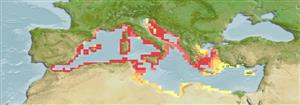Leptopsammia pruvoti Lacaze-Duthiers, 1897
Sunset cup coral| Native range | All suitable habitat | Point map | Year 2050 |

|
| This map was computer-generated and has not yet been reviewed. |
| Leptopsammia pruvoti AquaMaps Data sources: GBIF OBIS |
Classification / Names Common names | Synonyms | CoL | ITIS | WoRMS
Hexacorallia | Scleractinia | Dendrophylliidae
Environment: milieu / climate zone / depth range / distribution range Ecology
Reef-associated. Subtropical
Distribution Countries | FAO areas | Ecosystems | Occurrences | Introductions
Atlantic and the Mediterranean.
Length at first maturity / Size / Weight / Age
Maturity: Lm ? range ? - ? cm
Short description Morphology
This species is a non colonial stony coral. Calcareous skeleton: reaching exceptionally 0.80 cm vertically. Diameter of the polyps: 0.7 cm to the maximum, often much less. Round section; chalice somewhat narrowed at the base. Bodies and oral disc: yellow or oranges sharp, the tentacles white; translucidus and constellated with yellow punctuations which correspond to the clusters of cnidocytes (Ref. 358).
Calcareous skeleton: reaching exceptionally 0.80 cm vertically. Diameter of the polyps: 0.7 cm to the maximum, often much less. Depth: present beyond 10 m, seldom less, and until the greatest depths (Ref. 358).
Life cycle and mating behavior Maturity | Reproduction | Spawning | Eggs | Fecundity | Larvae
Members of the class Anthozoa are either gonochoric or hermaphroditic. Mature gametes are shed into the coelenteron and spawned through the mouth. Life cycle: The zygote develops into a planktonic planula larva. Metamorphosis begins with early morphogenesis of tentacles, septa and pharynx before larval settlement on the aboral end.
Main reference
References | Coordinator | Collaborators
Göthel, H. 1992. (Ref. 358)
IUCN Red List Status (Ref. 130435: Version 2024-1)
CITES status (Ref. 108899)
Appendix II: International trade monitored
CMS (Ref. 116361)
Not Evaluated
Threat to humans
Human uses
| FishSource |
Tools
More information
Trophic Ecology
Food items
Diet
Food consumption
Ration
Predators
Diet
Food consumption
Ration
Predators
Ecology
Population dynamics
Life cycle
Distribution
Human Related
Aquaculture profile
Stamps, Coins Misc.
Stamps, Coins Misc.
Outreach
References
Internet sources
BHL | BOLD Systems | CISTI | DiscoverLife | FAO(Publication : search) | Fishipedia | GenBank (genome, nucleotide) | GloBI | Gomexsi | Google Books | Google Scholar | Google | PubMed | Tree of Life | Wikipedia (Go, Search) | Zoological Record
Estimates based on models
Preferred temperature
(Ref. 115969): 15.8 - 19.3, mean 18 (based on 32 cells).
Price category
(Ref. 80766):
Unknown.



